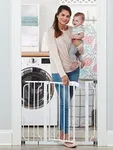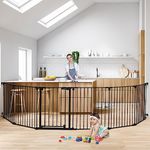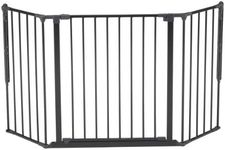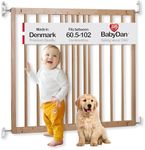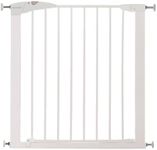Buying Guide for the Best Baby Gate For Top Of Stairs
Choosing the right baby gate for the top of the stairs is crucial for ensuring the safety of your child. The top of the stairs is a high-risk area, and a secure, well-fitted gate can prevent accidents. When selecting a baby gate, consider the specific needs of your home and the characteristics of the gate that will best suit your space and lifestyle. It's important to focus on the gate's safety features, installation method, and durability to ensure it provides the protection you need.Safety CertificationSafety certification is a crucial aspect when selecting a baby gate, as it ensures the product meets specific safety standards. Look for gates that have been certified by recognized safety organizations, which indicates they have passed rigorous testing for strength, durability, and safety. This is particularly important for gates at the top of stairs, where a failure could lead to serious injury. Always choose a gate with a recognized safety certification to ensure it provides the necessary protection for your child.
Installation TypeThe installation type of a baby gate is important because it affects how securely the gate will be mounted. For the top of stairs, hardware-mounted gates are recommended because they are bolted into the wall or banister, providing a more secure fit than pressure-mounted gates. Pressure-mounted gates are easier to install and remove but are not as secure, making them unsuitable for the top of stairs. Consider your ability to install a hardware-mounted gate and whether your space allows for it when making your choice.
MaterialThe material of a baby gate affects its durability, appearance, and safety. Common materials include metal, wood, and plastic. Metal gates are often the most durable and secure, making them a good choice for the top of stairs. Wood can be aesthetically pleasing and sturdy, but ensure it is well-constructed. Plastic gates are lightweight and easy to clean but may not be as strong. Consider the environment where the gate will be used and choose a material that offers the best combination of strength and style for your needs.
Width and HeightThe width and height of a baby gate are important to ensure it fits your space and provides adequate security. Measure the width of the stairway opening to ensure the gate will fit properly. Many gates are adjustable, but it's important to check the minimum and maximum width they can accommodate. The height of the gate should be tall enough to prevent your child from climbing over it. Generally, a height of at least 30 inches is recommended. Choose a gate that fits your space and provides a secure barrier for your child.
Latch MechanismThe latch mechanism of a baby gate is crucial for both security and convenience. It should be easy for adults to operate but difficult for children to open. Look for gates with a dual-action latch or a child-proof lock to ensure safety. Some gates offer one-handed operation, which can be convenient when carrying a child or other items. Consider how often you will need to open and close the gate and choose a latch mechanism that balances security with ease of use.
Swing DirectionThe swing direction of a baby gate is important for safety and convenience, especially at the top of stairs. Ideally, the gate should swing away from the stairs to prevent accidental falls. Some gates offer a one-way swing feature specifically for this purpose. Consider the layout of your space and how the gate will be used to determine the best swing direction for your needs. Ensure the gate can be installed to swing in the safest direction for your particular stairway.

